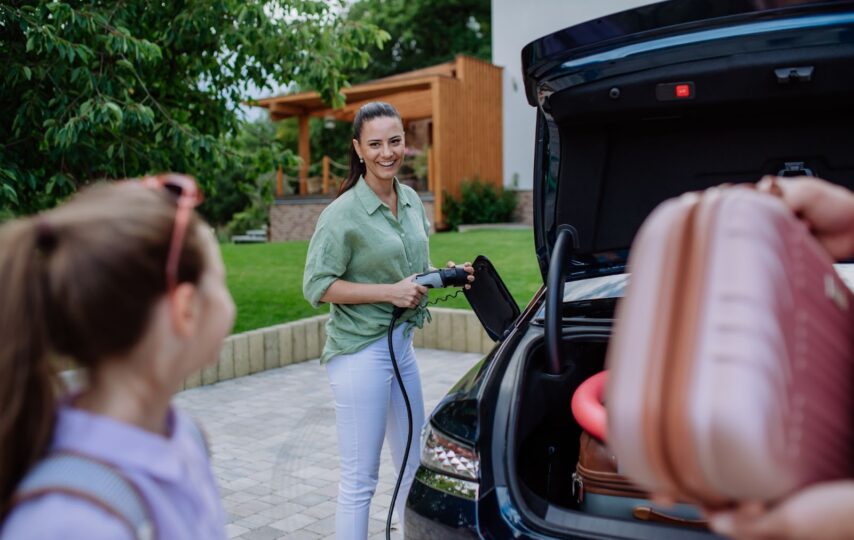Welcome to the future of driving! Switching to an electric vehicle demonstrates your smart thinking, yet you could be uncertain about the charging logistics. No need to stress – we’re here to help. This manual serves as your roadmap to maneuver the ever-expanding landscape of EV charging spots. Whether it’s the convenience of your residence, the ease of retail spots, or the pit stops on highways, we’ve taken care of everything. Let’s plunge into the specifics of ensuring your EV remains charged and all set to hit the road!
Understanding The Need For EV Infrastructure
Widely accessible charging infrastructure plays a pivotal role in the widespread adoption of EVs and in promoting environmentally friendly transportation. It addresses key concerns related to the adoption of EVs, such as limited driving range.
Key considerations during installation include:
- Following guidelines for charge point installations;
- Strategic placement for accessibility;
- Integrating fast-charging capabilities to minimize wait times, ensuring compatibility with various EV models;
- Incorporating renewable energy sources for sustainability.
Standardized payment systems, user-friendly interfaces, and routine maintenance are also essential for a smooth user experience. With all this in mind, various EV charging options emerged over the years. Let’s take a look at what they are!
1. At-Home Charging Stations
One of the most convenient and obvious places to power up an EV is at home. The comfort of your driveway or garage can become your EV charging station.
With a standard 120-volt outlet, you can easily plug in your car overnight for a full charge by morning. However, you might want to consider installing a 240-volt charging station for a quicker charge. This station type can give your EV a complete charge in as little as 4 to 6 hours.
Your at-home charging station provides convenience and lets you take advantage of off-peak electricity rates. But what to do when you’re out and about? Let’s explore where you can charge your vehicle when you go for a ride!
2. Public Charging Stations
On the go and need a power boost for your EV? Public charging stations are available in many downtown areas, shopping centers, and highway rest stops. These are typically Level 2 or DC fast chargers, making them faster than your at-home options. Some public charging stations may require membership, while others allow pay-as-you-go options.
Don’t forget to check pricing before you plug in. The costs can have a broad range and could be structured by the minute, kilowatt-hour (kWh), or a fixed rate. It’s also important to take into consideration that public charging stations might experience high usage, particularly during busy hours. To ensure a smooth experience, it’s recommended to plan your charging requirements thoughtfully and prevent any potential inconveniences.
3. Workplace Charging Options
Many companies now offer charging options at the workplace, making it even more convenient to keep your EV powered up.During your work hours, you have the opportunity to plug in your car, and when you’re finished, your vehicle will be fully charged. This is a substantial advantage for both employers and their workforce.
Your employer’s commitment to sustainability can aid in minimizing your carbon footprint. It also reduces the stress of finding a public charging station. You can use downtime and charge your car while busy with meetings or projects.
4. Charging at Retail Locations
Retailers are also joining the movement to offer charging stations for EVs.These charging spots are often situated within large shopping centers, grocery stores, and malls. Retailers are making a wise decision, understanding that as your car is being charged, you’re inclined to spend time (and money) in their outlets.
Most retail chargers are Level 2, providing a full charge in a few hours – perfect for a shopping trip or a meal. Some locations even offer charging as a complimentary service, making your shopping experience even more convenient.
However, always check the charging rates, as some might charge a fee. And remember to download a charging station locator app to find these handy retail charging points!
5. Highway Rest Stop Charging
Next time you’re on a long road trip, don’t forget there are often charging stations at highway rest stops. These charging points, typically found along major highways and interstates, are a godsend for EV drivers.They’re strategically positioned to motivate you to take a breather, stretch, indulge in some food, and return to a vehicle that’s revitalized.
The majority of these stations extend swift charging possibilities, permitting you to reach up to 80% charge in as little as 30 minutes. While waiting, use the facilities, enjoy a picnic, or take a quick nap. Sure, it might take a bit longer than filling up a gas tank but don’t worry. With the growing network of charging stations, your EV road trip is completely feasible.
6. Charging via Subscription Services
With subscription-based services, you usually pay a monthly fee and gain unlimited access to a network of charging stations. Companies like ChargePoint, EVgo, and Tesla Supercharger offer such services.
Not only do these subscriptions provide you with more locations to charge, but they also offer faster charging times. Plus, you can often reserve a charging port in advance—a boon during peak times. Do your research, as some subscriptions may suit your charging habits better than others. Remember, the goal is to make EV charging as seamless as possible.
Planning for Long Distance Travel with an EV
Range anxiety is a phenomenon where drivers fear their car’s battery will run out before finding a charging spot. This fear can make people hesitate to use electric cars for longer trips, even though many modern EVs can go far on a single charge.
But how to combat this concern? Planning a long road trip with your electric vehicle requires a bit more preparation, but it’s not as challenging as it may seem.
The key is to map out your route and identify charging stations along the way. Many GPS and EV apps can assist you with this task, showing you where to find the nearest charging locations. Don’t forget to factor in the time it takes to charge your vehicle.
Depending on your car’s battery and the charging station’s power, it can take anywhere from 30 minutes to several hours. Also, it’s a great idea to carry a portable charger or generator that can provide a small amount of charge in emergencies, helping you reach the next working station.
Wrapping Up
Switching to an electric car may seem tricky at first, but it’s actually quite simple! You can charge your car at home, at work, or even at public charging stations. These places are popping up more and more as people become more eco-friendly.
You just need to know what your car needs and plan your journeys. Yes, it might seem a bit confusing at first, but with a bit of homework and planning, you’ll find it as easy – maybe even easier – than filling up a regular car with petrol. So, let’s jump into this exciting change and enjoy the ride to a cleaner world!
Happy charging, and enjoy the ride!








